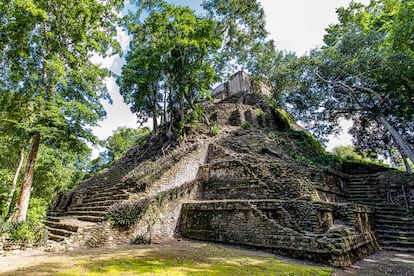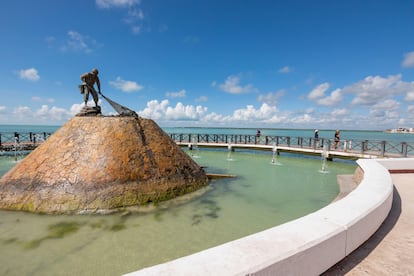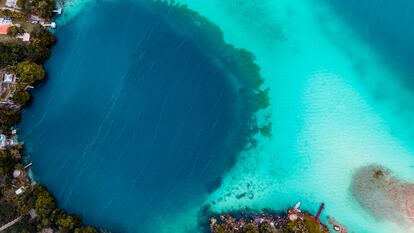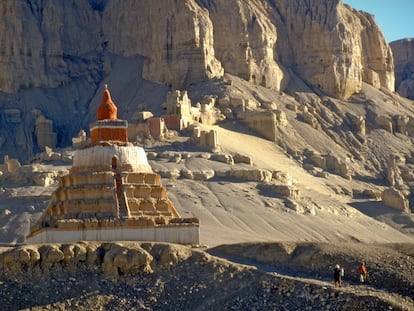24 hours in Chetumal: A one-day itinerary in the town where the beautiful Mexican Caribbean starts
The state capital of Quintana Roo has centuries of history, pristine beaches, and a fantastic boardwalk culture

On September 14, 2003, a newborn manatee was found in the Guerrero lagoon system next to Chetumal Bay in the Mexican state of Quintana Roo. The human community living around the bay instantly fell in love with him. They visited him and provided him with food. Someone named him Daniel. For his first 12 years he was in semi-captivity. When he had the chance to be completely free, what did he do? Did he go to explore the seas? No, he returned to Chetumal Bay to stay, as if someone had explained to him: “This is a sanctuary for threatened species like yours, it is a protected natural area where you will have sporadic company and plenty of seagrass to feed on.”
Since he returned, Daniel has become a tourist attraction and the friendly aquatic mammal lives happily with everyone who visits this important ecological conservation site. Daniel was the first project to rehabilitate, release, and monitor a specimen of the Trichechus manatus species. The biologists warned people not to give him food, but who paid attention? Nobody. And there is Daniel, like a fish in water (ha!), still the object of affection and jokes. There are those who jump into the sea and hug him and later post the photo on their social media. There are those who sing to him. There is even someone who prepares dinner for him.
These things happen in Chetumal, a city whose promotional material rightly claims: “Mexico begins here.” Of course, the city is located the starting point of the Mexican Caribbean, on border with Belize. It has a lot of history, great surroundings and that boardwalk culture that creates such a good vibe when the heat of the day leaves with the afternoon and the sun goes to bed.
9.00 a.m. Delicious chaya empanadas and soaking up the history
To get a good idea of a place and its history, there is nothing like a café that the native population idolizes for its delicious breakfasts. (1) The Café del Puerto (every port town has one) is an illustrious location that pays tribute to Chetumal’s logging, gum harvesting, and maritime past, when roads barely reached the town. The café offers Mexican breakfast staples, of course, and yummy local classics like chaya empanadas. It is noisy and full of families who are taking it easy and ordering another cinnamon coffee. There are giant television screens, and the air conditioning machines emit more noise than cold air, but the morning flows like a mountain stream.

In the surroundings of Chetumal there are archaeological remains from the pre-Hispanic era. One of these is Kohunlich, built in 500 B.C., whose temple of the masks is a highlight. Others are Dzibanché, founded around 200 B.C., and its neighboring acropolis of Kinichná. However, perhaps the most impressive site is Oxtankah (2). This pre-Hispanic city is an incredibly important Mayan site due to the presence of the first Catholic church built after the arrival of the Spanish. It is a chapel with a semicircular arch whose style clearly clashes with the rest of the buildings. Legend has it that it was here that the union of the Spanish Gonzalo Guerrero and the princess Zazil Há, daughter of the chief Nachán Can, took place. Their offspring are said to be the first mestizos. It is a detail that gives Chetumal the epithet “the cradle of miscegenation,” which is something that is certified by the sculpture of the Guerrero family known as the Allegory of Mestizos.
11.00 a.m. A ‘pozolazo’ and Mayan worldview
Anyone who has not yet fully woken up at this time will find an excuse to have a pozolazo in the colorful municipal market (3) . The pozol or the pochotl, a common drink among Mexicans around here, is a cold drink made of flour dough with natural cocoa. It has survived since pre-Columbian times, when it was drunk to quench thirst and hunger (it is practically chewed) and as an energizer. It is the perfect beverage to give you the energy to take on the Museum of Mayan Culture (4), one of the most important museum sites of the pre-Columbian civilization. The building is the work of the architect and museographer Jorge Agostini, who worked with the great Mexican architect Pedro Ramírez Vázquez. Agostini demonstrates here an accomplished management of space. The museum is divided into three floors equivalent to the three surfaces of the Mayan world: the earth, the sky, and the underworld.

As a whole, the visit offers an informative tour of the Mayan culture and its customs. Visitors learn about hunting and fishing, precious objects such as jade, the importance of corn as sustenance, and the ceiba tree as a sacred tree. The museum manages to capture the everyday life and grandeur of Mayan architecture and their worldview, through which they perceived that their existence and everything created by their divinities was harmonized with the cycles of nature.
13.00 p.m. ‘Gastro’ dilemma: tuna toast or lobster pizza?
If you find that you are hungry after absorbing all that culture, you should stop at Almina (5). The tuna toast and the catch of the day with lemon fit very well with a simple establishment facing the bay that is lapped by the waves that clean the curve of the boardwalk. Like everything in Chetumal, there is no trace of ostentation, but quite the opposite.
🍖Descubre sabores nuevos en Almina🤤🤤🤤 🎉 ORDENA O RESERVA: https://l.linklyhq.com/l/1fm9w MENÚ: https://l.linklyhq.com/l/1fup2 UBICACIÓN: https://l.linklyhq.com/l/1fup9 Hoy se antoja ir a Almina
Publicada por Almina en Jueves, 1 de junio de 2023
If you are not feeling peckish, it is worth considering going to the town of Mahahual (6). The journey takes a little over thirty minutes, yes, but it is worth it. This is the first beach on the Mexican Caribbean coast. The boardwalk that stretches from the lighthouse to the so-called fishing pier blends the townspeople and the relaxed tourists in such a way that it is difficult to differentiate them. There are stalls where you can find everything from winter ponchos to water wings. There is a local fisherman named Eider who offers snorkelling by the reef and then seafood and lionfish tasting in his own home. Be careful with the lionfish, the spine is poisonous. There are beach bars committed to conservation between whose tables a sign announces: “Wanted: filthy, evil monster that leaves this trail on the beaches” and four plastic bottles.

All along the beach you can see very large families with loaded coolers. The typical group consists of grandmothers and daughters under the umbrella, children playing wherever they want, and the men kneeling in a circle in the waist-deep water as if sitting on a submerged barstool with a beer in hand. A couple of tired-looking young Spanish women look at their cell phones on the sun lounger. Neither of them got enough sleep last night. There are some young Italian men looking at the blue of the sea imagining themselves living here. You have to be very picky not to consider this lack of mass tourism as something to be celebrated, and you have to be very strange not to succumb to the sublime culinary specialty of lobster pizza that they make so well in Luna de Plata, Quinto Sole, or No Hochkay. It’s so good it might derail your afternoon plans.
16.00 p.m. Quick trip to the rapids
There is no better gateway to Bacalar than its famous rapids (7). And the Bacalar lagoon is one of the seven natural wonders of Mexico. The narrow, secret channel is a 1,000-year-old natural sculpture made by turquoise blue waters bordered by stromatolites. In today’s globalized world it is difficult to find a place such as this, where tourists and locals mix so naturally.

You can kayak or simply put on a vest and let yourself drift in the current. Just enjoy the horizon of the sky and think about the art of inhabiting the world and the pleasure of finding it this way, and not leave any trace that you have been here, like in the Song of the Open Road by Whitman: “The earth, that is sufficient, I do not want the constellations any nearer, I know they are very well where they are, I know they suffice for those who belong to them.”
The ideal way to become familiar with the hues of the Bacalar lagoon is by boat. From the Amainah hotel (8) tours are organized around this natural wonder created from the most extensive system of freshwater stromatolites in the world. Rich in calcium carbonate, they have created the white seabed which feels like plaster when you step on it. It is a fragile ecosystem that requires due respect. The different depths cause an optical effect that causes the eye to see shades of blue. Inside the lagoon, the blue cenote is a scary 90 meters deep and 300 meters in diameter, be careful. As the hours go by and the light becomes dim, it is worth taking a few minutes to say goodbye to the day on the hotel terrace facing the lagoon, and watch the sun melt into the sea.

20.00 p.m. Perfect vacation dinner and time to reflect on the trip
Leaving behind the fort of San Felipe de Bacalar (9) and its echoes of battles and pirates, you can stroll through dimly lit streets. When a bus passes by on the back of which they have written “problems are passengers,” the rhythms of Immasoul (the Rosalía of Chetumal) come blasting from the bar La Jungla. Next door awaits the Finisterre Bacalar (10) restaurant, where you can once again enjoy lobster, this time on a spicy pasta.
You get the feeling that time is standing still in a place like this. The night comes after a busy day with so much packed into only 24 hours. The time spent in Chetumal may have been fleeting but the memories with stay with you for a long, long time.
Sign up for our weekly newsletter to get more English-language news coverage from EL PAÍS USA Edition
Tu suscripción se está usando en otro dispositivo
¿Quieres añadir otro usuario a tu suscripción?
Si continúas leyendo en este dispositivo, no se podrá leer en el otro.
FlechaTu suscripción se está usando en otro dispositivo y solo puedes acceder a EL PAÍS desde un dispositivo a la vez.
Si quieres compartir tu cuenta, cambia tu suscripción a la modalidad Premium, así podrás añadir otro usuario. Cada uno accederá con su propia cuenta de email, lo que os permitirá personalizar vuestra experiencia en EL PAÍS.
¿Tienes una suscripción de empresa? Accede aquí para contratar más cuentas.
En el caso de no saber quién está usando tu cuenta, te recomendamos cambiar tu contraseña aquí.
Si decides continuar compartiendo tu cuenta, este mensaje se mostrará en tu dispositivo y en el de la otra persona que está usando tu cuenta de forma indefinida, afectando a tu experiencia de lectura. Puedes consultar aquí los términos y condiciones de la suscripción digital.
More information
Archived In
Últimas noticias
Most viewed
- Sinaloa Cartel war is taking its toll on Los Chapitos
- Oona Chaplin: ‘I told James Cameron that I was living in a treehouse and starting a permaculture project with a friend’
- Reinhard Genzel, Nobel laureate in physics: ‘One-minute videos will never give you the truth’
- Why the price of coffee has skyrocketed: from Brazilian plantations to specialty coffee houses
- Silver prices are going crazy: This is what’s fueling the rally











































